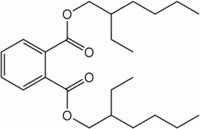Difference between revisions of "Diethylhexylphthalate"
| Line 21: | Line 21: | ||
DEHP has a low water solubility (0,003 mg/l), a very low tendency to vaporize and a high [[adsorption]] rate to particles. DEHP is a very stable chemical, it takes 2000 years to degrade it by inorganic mechanisms. It can however more easily be biodegraded. In areas with a high amount of biomass, the environmental [[half-life]] of DEHP is 50 days. | DEHP has a low water solubility (0,003 mg/l), a very low tendency to vaporize and a high [[adsorption]] rate to particles. DEHP is a very stable chemical, it takes 2000 years to degrade it by inorganic mechanisms. It can however more easily be biodegraded. In areas with a high amount of biomass, the environmental [[half-life]] of DEHP is 50 days. | ||
| − | DEHP has a tendency to [[bioaccumulation|bioaccumulate]]. It mainly accumulates through direct uptake from the water and not by food intake. Therefore, there is little risk for [[biomagnification]] through [[food chain|food chains]] and the same | + | DEHP has a tendency to [[bioaccumulation|bioaccumulate]]. It mainly accumulates through direct uptake from the water and not by food intake. Therefore, there is little risk for [[biomagnification]] through [[food chain|food chains]] as [[pollution and zooplankton|zooplankton]] and [[pollution and pelagic fishes|fish]] usually contain the same DEHP concentration. There might however be risks for [[pollution and sea birds|sea birds]] and [[pollution and marine mammals|marine mammals]] which eat large amounts of molluscs, crustaceans (particularly krill). |
| − | Concentrations above 0,1 mg/l | + | Concentrations above 0,1 mg/l cause acute toxicity in algae, invertebrates and fish. Long term exposure to concentrations above 3 µg/l might already cause [[endocrine disrupting compounds|endocrine disrupting effects]] in fish. Concentrations as low as 0,01 µg/l might alter the population sex ratio. DEHP might display an anti-estrogenic activity leading to a reduced [[Vitellogenins|vitellogenin]] content in females and other detrimental effects. It has also been shown to have an anti-estrogenic and anti-androgenic activity in rats. |
| − | Concentrations measured in [[estuary|estuaries]] usually between 0,05 µg/l and 2µg/l. | + | Concentrations measured in [[estuary|estuaries]] range usually between 0,05 µg/l and 2µg/l. These concentrations might already pose problems for certain marine organisms. Concentrations in the sediments of estuaries and [[fjord|fjords]] are between 0,0116 mg/kg and 16 mg/kg [[dry weight]]. <ref name = OECD>[http://www.ospar.org/documents%5Cdbase%5Cpublications%5CP00270_BD%20on%20phthalates%20_2006%20version_.pdf OSPAR Commission, 2006: OSPAR background document on phthalates]</ref> |
<P> | <P> | ||
<BR> | <BR> | ||
Revision as of 09:05, 28 August 2009
Definition of diethylhexylphthalate(DEHP):
Diethylhexylphthalate belongs to the family of phthalates: industrial chemicals used as plasticizers, softeners, adhesives or solvents used by a variety of industries. They are used in PVC, paints, printing inks, cosmetics, coatings of cars,... [1]
This is the common definition for diethylhexylphthalate(DEHP), other definitions can be discussed in the article
|
Notes
| Diethylhexylphthalate |
|---|

|
| Formula |
| C24H3804 |
In 1997, 476.000 tonnes of DEHP was used in the EU. These large quantities cause large amounts of DEHP to spread in the environment. DEHP is found in all environmental compartments, including remote areas. It mainly enters the marine environment through waste water from production sites, and through leakage from end products.[1]
DEHP has a low water solubility (0,003 mg/l), a very low tendency to vaporize and a high adsorption rate to particles. DEHP is a very stable chemical, it takes 2000 years to degrade it by inorganic mechanisms. It can however more easily be biodegraded. In areas with a high amount of biomass, the environmental half-life of DEHP is 50 days.
DEHP has a tendency to bioaccumulate. It mainly accumulates through direct uptake from the water and not by food intake. Therefore, there is little risk for biomagnification through food chains as zooplankton and fish usually contain the same DEHP concentration. There might however be risks for sea birds and marine mammals which eat large amounts of molluscs, crustaceans (particularly krill).
Concentrations above 0,1 mg/l cause acute toxicity in algae, invertebrates and fish. Long term exposure to concentrations above 3 µg/l might already cause endocrine disrupting effects in fish. Concentrations as low as 0,01 µg/l might alter the population sex ratio. DEHP might display an anti-estrogenic activity leading to a reduced vitellogenin content in females and other detrimental effects. It has also been shown to have an anti-estrogenic and anti-androgenic activity in rats.
Concentrations measured in estuaries range usually between 0,05 µg/l and 2µg/l. These concentrations might already pose problems for certain marine organisms. Concentrations in the sediments of estuaries and fjords are between 0,0116 mg/kg and 16 mg/kg dry weight. [1]
Environmental standards and legislation
Included in the OSPAR list of substances of priority action
Included in the water framework list of priority substances
See also
OSPAR background document on phthalates